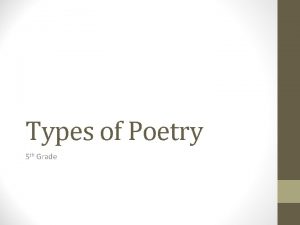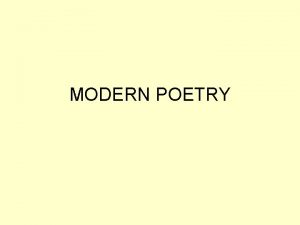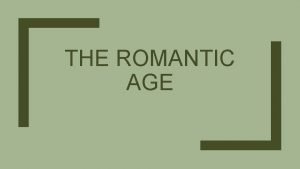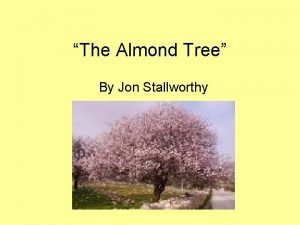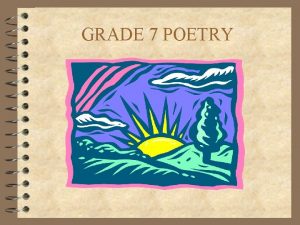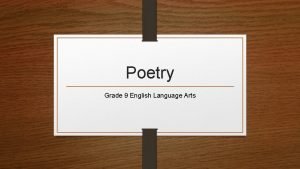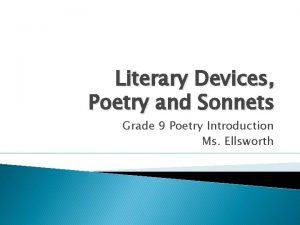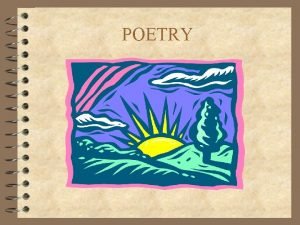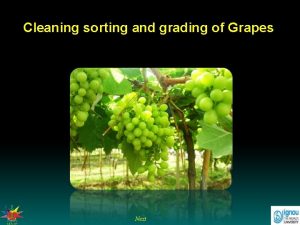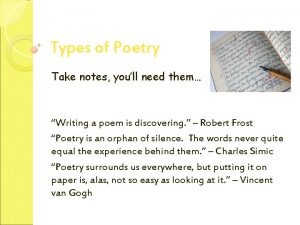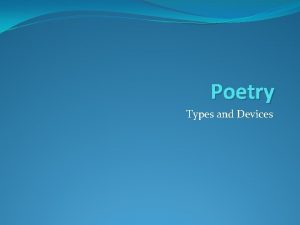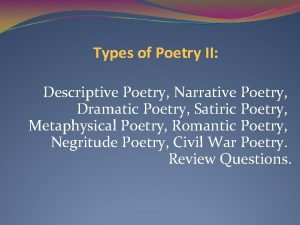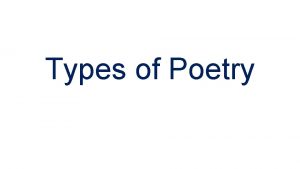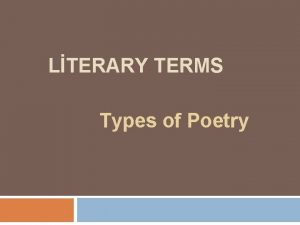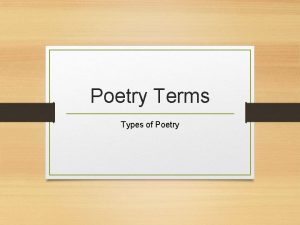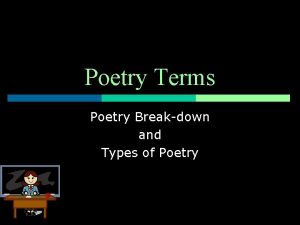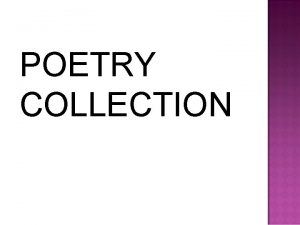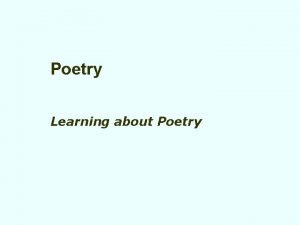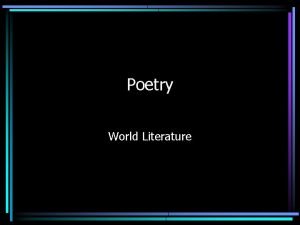Types of Poetry 5 th Grade Line a




















- Slides: 20

Types of Poetry 5 th Grade

Line: a unit of meaning (1 word, a phrase, or even a sentence) Stanza: lines that are grouped together (usually each has the same number of lines) Rhyme: The repetition of sounds at the end of lines or with in lines (rhyming pattern) Rhyme Scheme: The pattern of rhyme in a poem (aabb or abab)

Rhyming Scheme • Uses the letters of the alphabet to represent sounds to be able to visually “see” the pattern • Are labeled according to their rhyme sounds (aabbcc) • 1 st rhyme sound in a poem is “a” and each time the 1 st rhyme sound is heard, it is “a” • 2 nd rhyme sound in a poem is “b” and each time the 2 nd rhyme sound is heard, it is “b” • The pattern continues with “c”, “d”, etc.

My cat is nice. My cat likes mice. My cat is fat. I like my cat. A A B B My cat is nice. My cat is fat. My cat likes mice. I like my cat. A B My cat is gray. My cat is fat. My cat is cute. I like my cat. A B C B

I Like My Nose I’m glad that my nose points down to my toes, and doesn’t point up to the sky. For now I can sneeze just as much as I please, without getting goo in my eye. -Bruce Lansky

Free Verse • Written without rhyme or rhythm • Is very conversational – sounds like someone’s talking with you • Some do not use punctuation or capitalization, or other ways of breaking the rules of grammar. • A more modern type of poetry • Use your “senses” when writing

A Snowy Day A snowy day is white A snowy day is snowmen and snow angels A snowy day is sledding A snowy day is cold Cold Wear your coat, hat, gloves and scarf. See your breath. My teeth shiver. Listen to the wind blow. The cold smells like frozen snow.

Mother to Son Well, son, I'll tell you: Life for me ain't been no crystal stair. It's had tacks in it, And splinters, And boards torn up, And places with no carpet on the floor— Bare. But all the time I'se been a-climbin' on, And reachin' landin's, And turnin' corners, And sometimes goin' in the dark Where there ain't been no light. So, boy, don't you turn back. Don't you set down on the steps. 'Cause you finds it's kinder hard. Don't you fall now— For I'se still goin', honey, I'se still climbin', And life for me ain't been no crystal stair. Langston Hughes

Acrostic A poem in which the first letter of each line spells out a word, name, or phrase when read vertically.

Music M y head is full of rhythm U ntil I can barely sit still S ee me move to the beat I t does the same for others C an you feel the magic of music?

Teacher T akes time to listen E ach student is important A lot of patience C ares about learning H as all the answers (or will look it up!) E ach day a new adventure R eally organized (most of the time!)

Concrete poetry Verse that emphasizes nonlinguistic elements in its meaning, such as a typeface that creates a visual image of the topic.


Haiku (or hokku) A Japanese verse form of three unrhyming lines in five, seven, and five syllables. It creates a single, memorable image.

What are Haikus? • A 3 line poem consisting of 17 syllables. • (5 -7 -5 pattern) • 1 st line = 5 syllables • 2 nd line = 7 syllables • 3 rd line = 5 syllables • Ancient Japanese form of poetry • Typically expresses a single thought, feeling or idea • Usually has nature themes • Does not rhyme

Worm At / night, / qui / et / ly, a / worm / un / der / the / moon / light digs / in / to / a / nut.

Limerick A limerick is a silly poem with five lines.

How to write a limerick: The first, second and fifth lines rhyme with each other and have the same number of syllables (typically 8 or 9). The third and fourth lines rhyme with each other and have the same number of syllables (typically 5 or 6) Limericks often start with the line "There once was a. . . " or "There was a. . . " Example of an 8, 8, 5, 5, 8 syllable limerick:

STAR by Kaitlyn Guenther There once was a wonderful star Who thought she would go very far Until she fell down And looked like a clown She knew she would never go far.

 Types of poetry 5th grade
Types of poetry 5th grade Adjustable cross staff in surveying
Adjustable cross staff in surveying Neoclassical and romantic poetry
Neoclassical and romantic poetry Traditional poetry vs modern poetry
Traditional poetry vs modern poetry Narrative poem definition
Narrative poem definition Augustan age characteristics
Augustan age characteristics The almond tree poem
The almond tree poem Poems for grade 7
Poems for grade 7 Elements of poetry grade 9
Elements of poetry grade 9 Sonnet 18 theme
Sonnet 18 theme Formal division of lines in a poem.
Formal division of lines in a poem. Tercet poems
Tercet poems Grade equivalent in college
Grade equivalent in college Jumping rope history
Jumping rope history What is the white part of an egg called
What is the white part of an egg called Milk grade
Milk grade Grade grade
Grade grade Low grade and high grade metamorphic rocks
Low grade and high grade metamorphic rocks Angles on a straight line worksheet grade 5
Angles on a straight line worksheet grade 5 Types of poetry notes
Types of poetry notes A story narrative in poetic form
A story narrative in poetic form
